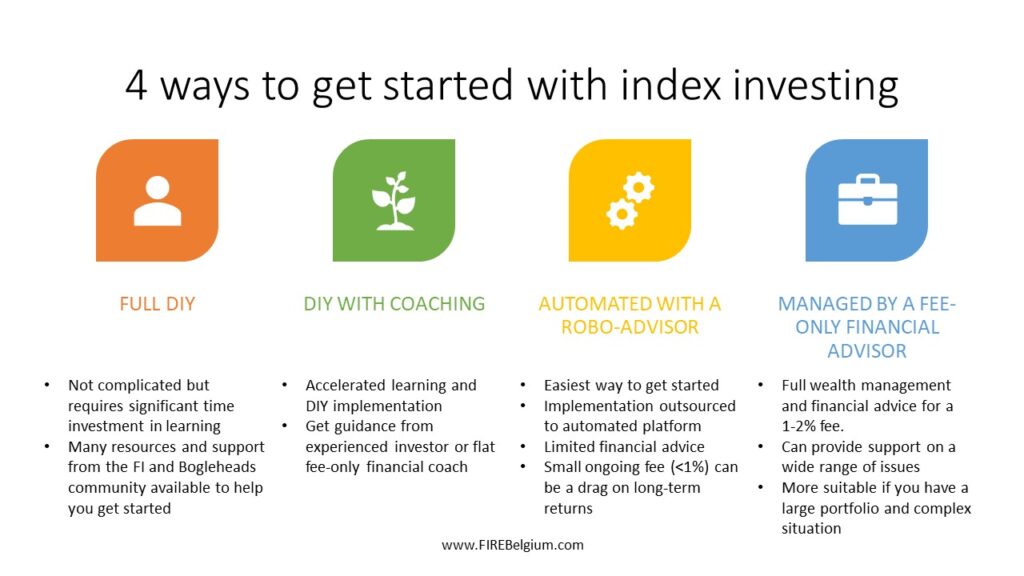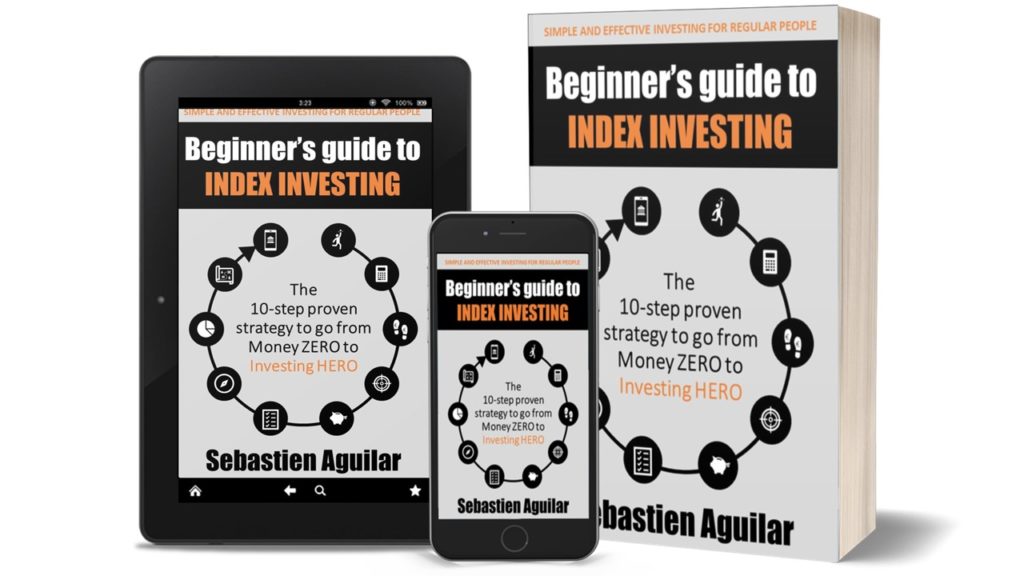Index investing is a simple and effective approach to investing and growing your wealth, without taking unnecessary risks.
The evidence that passively managed index investing outperforms the vast majority of active managers over the long term is overwhelming. Knowing that, individual investors are most often better off simply investing in a balanced portfolio of index funds.
If you want to learn how to invest effectively in index funds from Belgium, I recommend you download your copy of the Beginner’s Guide to Index Investing, where I layout the 10 steps to start investing in index funds effectively from Belgium.
How do you invest in index funds?
In the US, where index investing has been made very popular thanks to Vanguard and its founder Jack Bogle initially, index investing can be done by opening an account with mutual fund managers and simply buying into their index funds.
Outside of the US and a few other countries, the best way for individual investors to invest in index funds is by purchasing Exchange Traded Funds (ETFs) on the stock market via an online broker.
The process looks like this:

Popular brokers in Belgium include Binck Bank, Bolero, Degiro and Keytrade. Due to the local Belgian tax rules, index investors in Belgium often invest in Vanguard ETFs (such as VWCE) or iShares ETFs (such as IWDA) domiciled in Ireland and traded on European stock exchanges (such as Amsterdam, Frankfurt or Milan) via their online brokers.
Index investing is actually quite simple. But while the approach described above can seem rather straightforward, index investing requires a minimum level of knowledge to be executed properly and avoid costly mistakes.
I started investing in 2012, and I have found that there are several ways to get started with index investing, each with their own pros and cons.
In summary, here are the 4 ways to invest in index funds, from full Do-It-Yourself (DIY) to fully outsourced to a fee-only financial advisor:

Full DIY Index Investing
Full DIY investing means that the investor has learned everything on his/her own and is managing his/her investment completely by themselves. This is how I started investing in index funds. This approach requires a lot of learning and hence a significant time investment upfront before being able to start.
Luckily there are a lot of resources available to help DIY investors learn about how to invest in index funds on their own. It’s not always easy to find, but it exists. There are also communities that focus on supporting DIY index investing. One such community (and the one I recommend you join) are the Bogleheads. I highly recommend you read through both their Getting Started and Bogleheads Investing Philosophy pages before you consider doing anything else. The whole website is full of great information, provided and maintained by individual investors, for individual investors. If you live in Belgium, you should also join Financial Independence Belgium (on Facebook or Meetup). The group is very active with ongoing discussions online about investing as well as regular meetups. Make sure you also get your copy of the Beginner’s Guide to Index Investing, where I layout the 10 steps to start investing in index funds effectively from Belgium.
The main benefits of DIY investing is that you are in full control of your finances (provided that you have the right knowledge) and as there are no ongoing management fees by a third party, you can keep costs low (which is one of the core index investing principles). If you are pursuing financial independence, ongoing fees play a big role in determining how much you need to get to FI and how long it will take to get there.
DIY Index Investing with coaching or guidance
The second way to get started with index investing is to find someone who can help you. What you need here is the advice and guidance of an experienced investor who has been investing for a while and has experience helping others get started. Someone who will provide you with the right resources, teach you the core principles, answer your questions and take you through the process so that you avoid making mistakes.
Working with a guide can basically accelerate your learning and then help you move faster through planning and implementation of your investment strategy. This approach will save you time and get to results faster. This is ideal for people who do not want to deal with everything on their own, especially at first as it can feel overwhelming.
Working with a guide gives you the confidence that you are doing it “the right way” and that you are not missing anything important.
Note that a guide is not a financial advisor. A guide will show you the way, coach you through your own decision process but will not give you financial advice. A guide will also often be far cheaper than a financial advisor and will only charge a fixed fee for his/her time and advice.
FIRE Belgium now provides coaching and guidance. You can learn more about our programs here.
Automated DIY Investing with a Robo-advisor
The last decade has seen the rise of a new type of platform for investing: robo-advisors. Robo-advisors provide financial advice or investment management services based on mathematical rules and algorithms executed by software. This allows economies of scale as there is less human intervention required in the management of the assets. It can therefore be offered for cheaper prices and to smaller investors compared to traditional financial advice.
Many robo-advisory firms build portfolios of index funds for their investors, making it an easy and convenient way for most individual investors to get a balanced portfolio, aligned with most core principles of index investing.
When working with a robo-advisor, the investors often have to fill in an online questionnaire that will determine their level of risk and preferences. Based on that information, the robo-advisor will assign them an corresponding investment portfolio. Robo-advisors typically charge an ongoing management fee of between 0.5% (for large portfolios) to 1% (for small portfolios) for the service.
This is an excellent way for many investors to get started with index investing as it allows them to start fast and invest with the guidance of the robo-advisor. Just make sure the portfolio they assign to you is composed of low cost broadly diversified index funds and that the robo-advisor adheres to the simple investing philosophy of the Bogleheads.
There are a few robo-advisors in Belgium that will invest for you following the Bogleheads philosophy.
- Curvo, a robo-advisor launched in 2021 focused on solving the pension crisis for the younger generation in Belgium. You can check my interview with Curvo’s co-founder Yoran Brondsema here.
- Easyvest, one of the first robo-advisors in Belgium. You can check my interview with Easyvest’s co-founder Corentin Scavee here.
While the benefits are obvious, it is also important to mention the main drawback: the ongoing fees will add up and compound over time. If the investor is aiming to achieve financial independence, this extra fee can lead to several additional years of work and investment. We will explore the impact of fees in a future article.
Index investing with a fee-only financial advisor.
For investors with large assets, complex financial situations and who need advice beyond the construction of a portfolio of index funds, working with a fee-only financial advisor can be recommended. These advisors will be able to provide advice on taxes, estate planning, pensions planning, etc. with more depth. Getting the right advice in these areas is really important.
Typically fee-only advisors will charge an ongoing management fees from 1% per year and up.
Similarly to robo-advisors, these fees will quickly add up over the years and put a drag on your portfolio growth. In some cases that can be justified, but if you’re only looking for investment advice, then you’re probably better off with one of the other options as the high fees of financial advisors will outweigh any additional investment return they might provide over the long term.
And again, you need to make sure that the portfolio they build for you is composed of low cost broadly diversified index funds following the simple and effective investing philosophy of the Bogleheads.
Warning
Beware of so-called financial advisors who help you sign up to any sort of insurance-based regular savings plan. These plans come with a lot of hidden layers of fees, all designed to incentivize the advisor into selling more of them and keep you in the dark. I have seen plans with total ongoing fees of up to 5.5%, when on the surface they looked like they only had something like a 1% management fee. These plans will often be sold by advisors who offer to give you advice for free (some will disclose that they get paid by the product provider, but not all). When I first started investing, not knowing any better and because all the advisors I was speaking to were promoting them, I signed up for one of those products and it really hurts. Beyond the outrageous fees, these plans are designed to keep you locked in and if anything ever changes in your life and you need to withdraw the money, you would face very high surrender fees, often costing you a very large portion of your portfolio.
If you really have to, make sure the advisor you decide to work with is completely independent, paid only by you (no incentive to sell you any product but only to serve you well), and ideally is a fiduciary financial advisor. You also want to work with someone who understands the power of passive index investing in the long term and is not trying to get you to chase short term gains.



One thought on “4 ways to get started with index funds investing in Belgium”